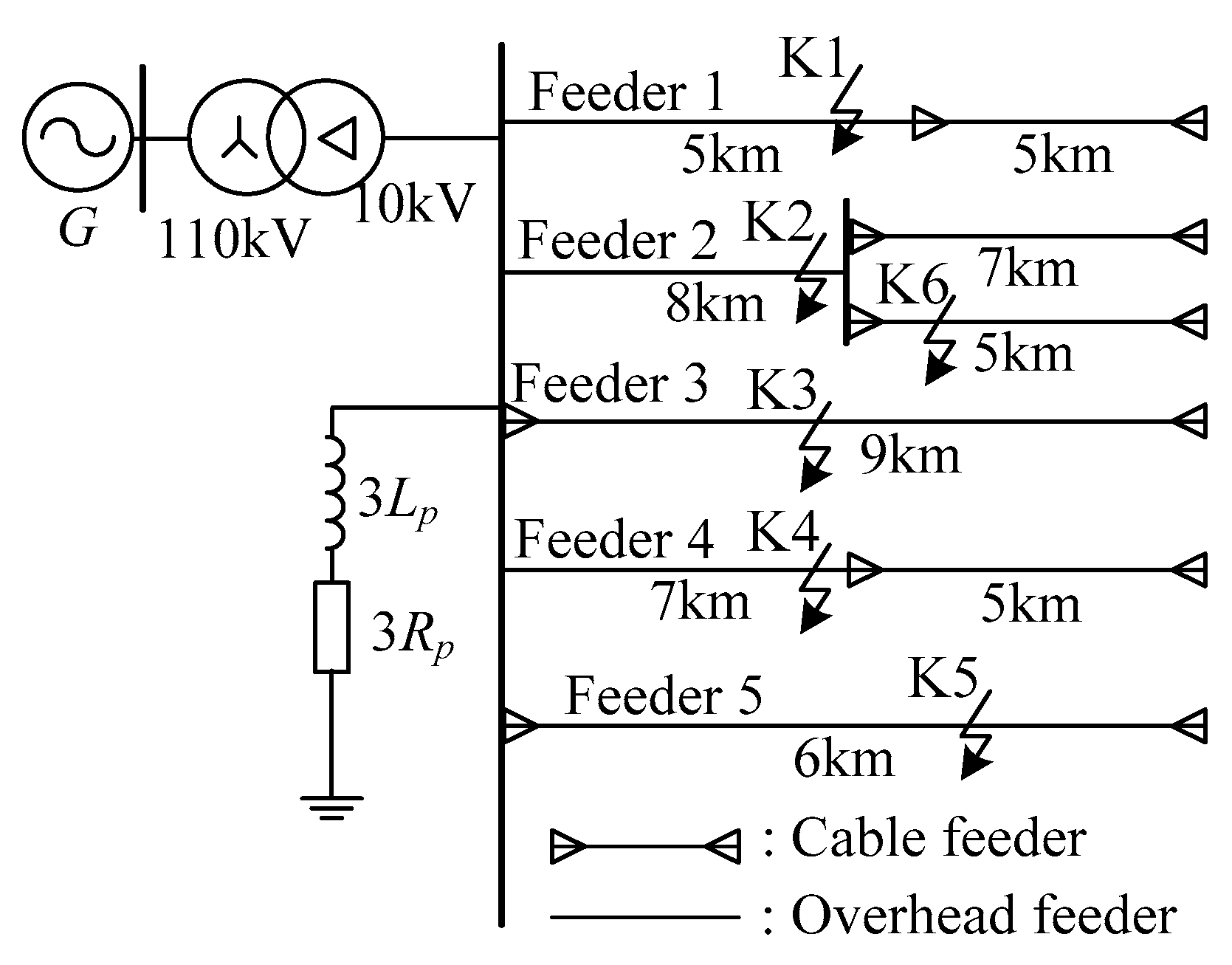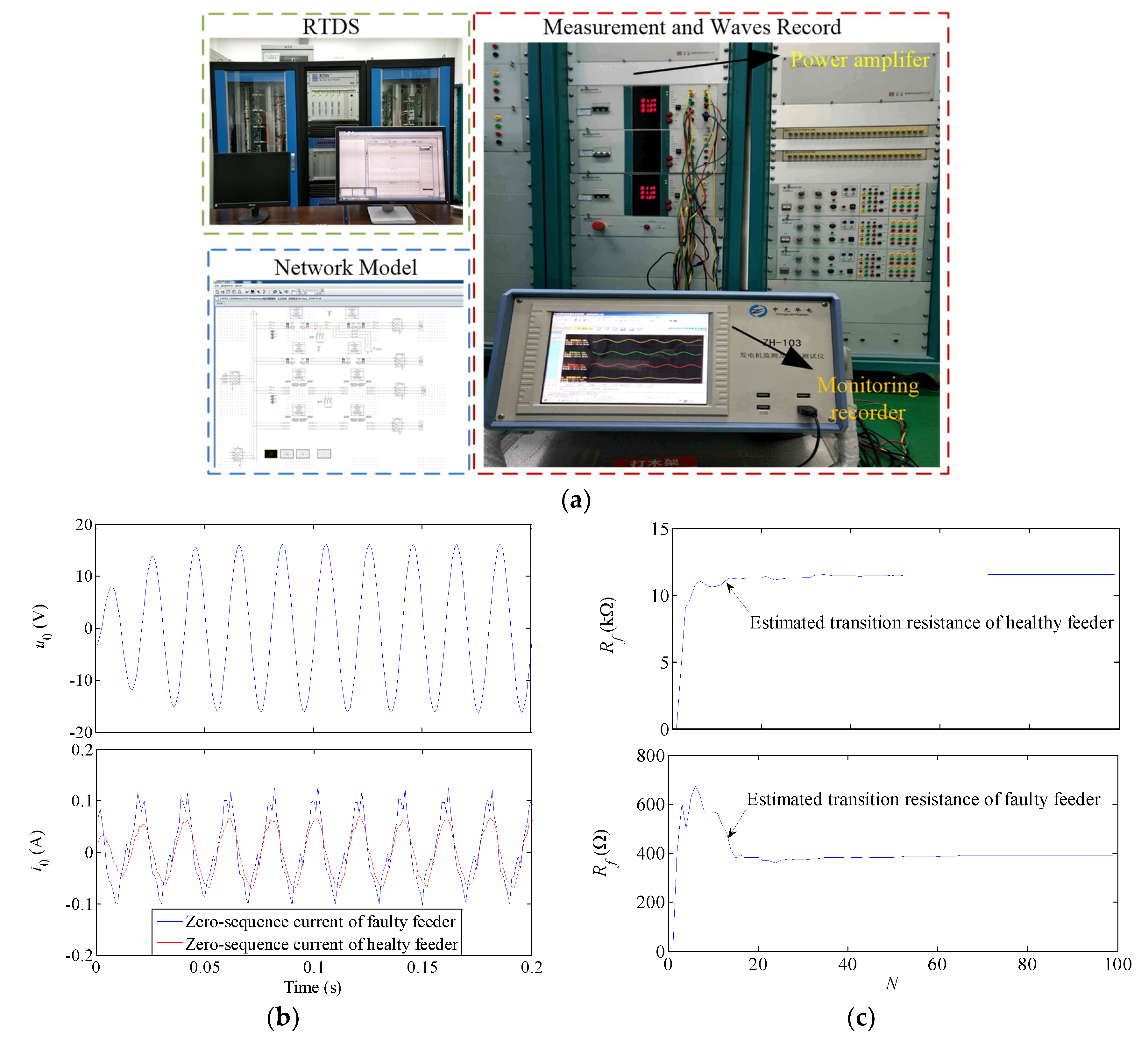Identifying Faulty Feeder for Single-Phase High Impedance Fault in Resonant Grounding Distribution System
Abstract
:1. Introduction
2. The Analysis of Fault Characteristic for the Single-Phase HIF in RGDS
2.1. Equivalent Zero-Sequence Network for a HIF
2.2. The Over-Damping State
2.3. The Under-Damping State
3. Identification Principle
3.1. Basic Principle
3.2. Start-Up Criterion
4. Identification Principle
4.1. Simulation Model
4.2. Simulation Results
4.2.1. Simulation Verification in Over-Damping State
4.2.2. Simulation Verification in Under-Damping State
4.2.3. Simulation Verification under Different Fault Conditions
4.2.4. Comparison with Other Methods
4.3. RTDS Based Experiment Results
5. Conclusions
Author Contributions
Funding
Conflicts of Interest
References
- Dong, X.; Shi, S. Identifying single-phase-to-ground fault feeder in neutral noneffectively grounded distribution system using wavelet transform. IEEE Trans. Power Deliv. 2008, 23, 1829–1837. [Google Scholar] [CrossRef]
- Zeng, X.; Li, K.K.; Chan, W.L.; Su, S.; Wang, Y. Ground-fault feeder detection with fault-current and fault-resistance measurement in mine power systems. IEEE Trans. Ind. Appl. 2008, 44, 424–429. [Google Scholar] [CrossRef]
- Wang, X.; Song, G.; Chang, Z.; Luo, J.; Gao, J.; Wei, X.; Wei, Y. Faulty feeder detection based on mixed atom dictionary and energy spectrum energy for distribution network. IET Gener. Transm. Distrib. 2017, 12, 596–606. [Google Scholar] [CrossRef]
- Zamora, I.; Mazón, A.J.; Sagastabeitia, K.J.; Zamora, J.J. New method for detecting low current faults in electrical distribution systems. IEEE Trans. Power Deliv. 2007, 22, 2072–2079. [Google Scholar] [CrossRef]
- Lin, X.; Sun, J.; Kursan, I.; Zhao, F.; Li, Z.; Li, X.; Yang, D. Zero-sequence compensated admittance based faulty feeder selection algorithm used for distribution network with neutral grounding through Peterson-coil. Int. J. Electr. Power Energy Syst. 2017, 32, 23–32. [Google Scholar] [CrossRef]
- Personal, E.; García, A.; Parejo, A.; Larios, D.F.; Biscarri, F.; León, C. A comparison for impedance-based fault location methods for power underground distribution systems. Energies 2016, 9, 1022. [Google Scholar] [CrossRef]
- Sang, Z.; Zhang, H.; Pan, Z.; Tian, Z. Protection for single phase to earth fault line selection for ungrounded power system by injecting signal. Autom. Electr. Power Syst. 1996, 20, 11–12. [Google Scholar]
- Huang, C.; Tang, T.; Jiang, Y.; Hua, L.; Hong, C. Faulty feeder detection by adjusting the compensation degree of arc-suppression coil for distribution network. IET Gener. Transm. Distrib. 2018, 12, 807–814. [Google Scholar] [CrossRef]
- Lin, X.; Huang, J.; Ke, S. Faulty feeder detection and fault self-extinguishing by adaptive Petersen coil control. IEEE Trans. Power Deliv. 2011, 26, 1290–1291. [Google Scholar] [CrossRef]
- Zhang, Z.; Liu, X.; Piao, Z. Fault line detection in neutral point ineffectively grounding power system based on phase-locked loop. IET Gener. Transm. Distrib. 2014, 8, 273–280. [Google Scholar]
- Li, Y.; Meng, X.; Song, X. Application of signal processing and analysis in detecting single line-to-ground (SLG) fault location in high-impedance grounded distribution network. IET Gener. Transm. Distrib. 2016, 18, 382–389. [Google Scholar] [CrossRef]
- Cui, T.; Dong, X.; Bo, Z.; Juszczyk, A. Hilbert-transform-based transient/intermittent earth fault detection in noneffectively grounded distribution systems. IEEE Trans. Power Deliv. 2011, 26, 143–151. [Google Scholar] [CrossRef]
- Michalik, M.; Rebizant, W.; Lukowicz, M.; Lee, S.-J.; Kang, S.-H. High-impedance fault detection in distribution networks with use of wavelet-based algorithm. IEEE Trans. Power Deliv. 2006, 21, 1793–1802. [Google Scholar]
- Sarlak, M.; Shahrtash, S.M. High impedance fault detection using combination of multi-layer perceptron neural networks based on multi-resolution morphological gradient features of current waveform. IET Gener. Transm. Distrib. 2011, 5, 588–595. [Google Scholar] [CrossRef]
- Etemadi, A.H.; Pasand, M.S. High-impedance fault detection using multi-resolution signal decomposition and adaptive neutral fuzzy inference system. IET Gener. Transm. Distrib. 2008, 2, 110–118. [Google Scholar] [CrossRef]
- Wang, Y.; Huang, Y.; Zeng, X.; Wei, G.; Zhou, J.; Fang, T.; Chen, H. Faulty feeder detection of single phase-earth fault using grey relation degree in resonant grounding system. IEEE Trans. Power Deliv. 2017, 32, 55–61. [Google Scholar] [CrossRef]
- Suresh, G.; Sukumar, M.B. Detection of high impedance fault in power distribution systems using mathematical morphology. IEEE Trans. Power Syst. 2013, 28, 1226–1234. [Google Scholar]
- Jota, F.G.; Jota, P.R.S. High-impedance fault identification using a fuzzy reasoning system. IET Gener. Transm. Distrib. 1998, 145, 656–661. [Google Scholar] [CrossRef]
- Ghaderi, A.; Mohammadpour, H.A.; Ginn, H.L.; Shin, Y. High-impedance fault detection in the distribution network using the time-frequency-based algorithm. IEEE Trans. Power Deliv. 2015, 30, 1260–1268. [Google Scholar] [CrossRef]
- Henriksen, T. Faulty feeder identification in high impedance grounded network using charge-voltage relationship. Electr. Power Syst. Res. 2011, 81, 1832–1839. [Google Scholar] [CrossRef]
- Li, T.Y.; Xue, Y.D.; Xu, B.Y. High-impedance fault detection technology based on transient information in a resonant grounding system. CIRED Open Access Proc. J. 2017, 2017, 1176–1179. [Google Scholar] [CrossRef]










| Fault Points | Rf (Ω)/θ (°) | Feeder 1 Rf (kΩ) | Feeder 2 Rf (kΩ) | Feeder 3 Rf (kΩ) | Feeder 4 Rf (kΩ) | Feeder 5 Rf (kΩ) | Rset | Identifing Results |
|---|---|---|---|---|---|---|---|---|
| K1 | 2000/90 | 2.0840 | 8.1000 | 10.535 | 20.674 | 17.339 | 5 kΩ | Feeder 1 |
| 900/0 | 0.8560 | 8.7230 | 10.917 | 18.687 | 17.856 | |||
| K2 | 1200/90 | 20.745 | 1.1610 | 10.492 | 20.477 | 17.257 | Feeder 2 | |
| 150/45 | 23.304 | 0.1450 | 10.099 | 27.389 | 18.840 | |||
| K3 | 1500/100 | 20.804 | 8.0970 | 1.4950 | 20.534 | 17.283 | Feeder 3 | |
| 200/135 | 14.619 | 15.681 | 0.2010 | 15.787 | 17.316 | |||
| K4 | 1800/75 | 21.156 | 8.1980 | 10.716 | 1.6030 | 17.625 | Feeder 4 | |
| 500/60 | 21.138 | 8.5720 | 10.583 | 0.4850 | 17.401 | |||
| K5 | 1000/150 | 21.112 | 8.2860 | 10.658 | 17.525 | 0.9440 | Feeder 5 | |
| 350/30 | 23.024 | 8.8770 | 10.555 | 22.297 | 0.3460 | |||
| K6 | 100/45 | 23.372 | 0.1010 | 11.006 | 25.875 | 17.900 | Feeder 2 |
| Methods | Extracted Characteristic | Faulty Feeder | Result | ||||
|---|---|---|---|---|---|---|---|
| PM | 21.11 | 8.284 | 10.66 | 0.968 | 17.53 | feeder 4 | right |
| FHM | 0.034 | 0.070 | 0.061 | 0.062 | 0.042 | feeder 2 | wrong |
| WPEM | 1368 | 7898 | 4187 | 6402 | 1862 | feeder 2 | wrong |
© 2019 by the authors. Licensee MDPI, Basel, Switzerland. This article is an open access article distributed under the terms and conditions of the Creative Commons Attribution (CC BY) license (http://creativecommons.org/licenses/by/4.0/).
Share and Cite
Tang, T.; Huang, C.; Li, Z.; Yuan, X. Identifying Faulty Feeder for Single-Phase High Impedance Fault in Resonant Grounding Distribution System. Energies 2019, 12, 598. https://doi.org/10.3390/en12040598
Tang T, Huang C, Li Z, Yuan X. Identifying Faulty Feeder for Single-Phase High Impedance Fault in Resonant Grounding Distribution System. Energies. 2019; 12(4):598. https://doi.org/10.3390/en12040598
Chicago/Turabian StyleTang, Tao, Chun Huang, Zhenxing Li, and Xiuguang Yuan. 2019. "Identifying Faulty Feeder for Single-Phase High Impedance Fault in Resonant Grounding Distribution System" Energies 12, no. 4: 598. https://doi.org/10.3390/en12040598




